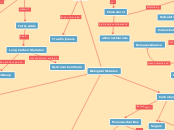Biological Molcules
Protiens
Amino Acid
Polypeptide
Peptide bonds
Covalent bonds
Disulfide Bridges
Polypeptide backbone
Carboxyl Group
C-Terminus
Amino Group
N-Terminus
R-Group (Side Chain)
Basic amino acid
Hydrophillic
Acidic amino acid
Polar
-OH
NH
SH
CO
Nonpolar
Ring
CH
H (C-H)
Van der Waals
H Atom
Protein Structure
Primary Structure
Linear chain of amino acid
Secondary Structure
Hydrogen bonds
Alpha Helix
coil
Beta Pleated Sheets
Fibrous Proteins
Subtopic
2 Parallel Segments
Tertiary Structure
3D Shape
Hydrophobic interaction
End up at the core
Quaternary Structure
Polypeptide subunits
polypeptide chain
Denatured
Chaperonin
Harmful environments
Nucleic Acids
Nucleotides
5 Carbon sugar
Nitrogenous base
Pyrimidine
Uracil
Thymine
Cytosine
Purines
Adenine
Guanine
Has hydroxyl group attached to a 3' Carbon
Has phosphate attached to a 5' Carbon
Phosphate groups
Phosphodiester linkage
DNA
deoxiribose
O atom in 2nd C
Double helix
Antiparallel
RNA
ribose
Single Strand
Polynucleotides
Lipids
True Polymers
Fats
Gylcerol
Alcohol
-OH Group
Fatty Acids
Long Carbon Skeleton
Carboxyl Group
Hydrocarbon Chain
3 Fatty Acids
Glycerol
Ester Linkage
Saturated Fatty Acid
Double bonds
-Cis Double bonds
Animal Fats
Solid
Unsaturated Fatty Acid
liquid
Plants
fished (oils)
Energy Storage
Phopholipids
Cell membranes
2 Fatty Acid
glycerol
Phosphate Grorup
Negative Charge
Hydrocarbon Tails
Hydrophobic
Water
Hydrophillic Head
Polar molecule
Bilayer
cell
Steroids
4 fused rings
Cholesterol
atheroschlerosis
Saturated and Transfats
Carbohydrates
Monosaccharides
Glucose
Sugars
Aldose (Aldehyde Sugar)
Ketose (Ketone Sugar)
Disaccharides
Glycosidic Linkage
Covalent bonds
Maltose
Glucose
Glucose
Sucrose
Glucose
Fructose
Lactose
Glucose
Galactose
Polysaccharides
Storage Material
Provides sugars for cells
Starch
Glucose monomers
1-4 Linkage
Alpha Configuration
On top
Amylose
Unbranched
Amylopectin
Branched
1-6 Linkage
Helical structure
Building Material
Protects the cell
Cellulose
Tough walls in plant cells
Beta Configuration
On Bottom
Straight Structure
Microfibrils
Chitin
Beta Linkages
Proteins
Glycogen
Glucose
Extensively branched
Releases Glucose
Genetics
Experiments
Griffith's experiment
S (smooth strain)
Mouse dies
Mouse healthy
Mouse dies
R (rough strain)
Mouse healthy
Hershey and Chase
Tag protein
Tag DNA
bacterial cell
DNA function as genetic material
Chargaff's rules
% of A and T bases are about equal
% of C and G are about equal
Meselson and Stahl
Semiconservative
3 models
conservative model
semiconservative model
dispersive model
DNA Replication
Proteins
helicase
Double Helix
Single strand binding protein
Single stranded DNA
Topoisomerase
Breaking and rejoining strands
Primase
RNA Primer
DNA Polymerase III
New DNA Strand
DNA Polymerase I
DNA nucleotides
DNA Ligase
nucleotide excision pair
Transcription
DNA
RNA
Initiation
Transcription Factors
elongation
RNA Poly.
nucleotides
3' end
termination
Polyadenylation signal sequence
Polyadenylation signal
Codons
nucleotide bases
Molecular components
RNA Polymerase
Promoter
TATA Box
Downstream
Upstream
Transcription unit
RNA Processing
5' cap
Poly-A Tail
Export of mRNa
Degrading
RNA Splicing
Introns
noncoding
Exons
coding
Spliceosome
Translation
Polypeptide
info in mRNA
Ribosome
coupling of tRNA anticodons with mRNA condons
Large subunit
P site
tRNA carrying growing polypeptide chain
A site
holds the next tRNA
E site
tRNAs
Small Subunit
mRNA binding site
Free ribosomes
cytosol
Bound ribosome
ER
nuclear envelop
Endomembrane system
nuclear envelop
ER
Golgi apparatus
lysosome
vacuoles
Plasma membrane
signal peptide
Signal-recognition particle
tRNA
anticodon
Stages
Initiation
Initiation factors
translation initiation complex
Elongation
Elongation factors
1st and 3rd step
Termination
Stop codon
UAG
UAA
UGA
release factor
Happens at the same time
Energy
Metabolism
Catabolic pathway
releases energy
exergonic reactions
Anabolic pathway
consume energy
endergonic reactions
Photosynthesis
Photorespiration
inefficient
CAM PHotosynthesis
PEP Carboxylase
oxaloacetate
Malic acid
vacuole
take place at night
H2O loss
Light reactions
Photosystem II (p680)
2 electrons
ETC
Photosystem I
2 NADPH
Primary electron acceptor
chemiosmosis
protons
thalakoids
gradients
ATP Synthase
1-2 ATP
Dark reactions (Calvin cycle)
Carboxylation
reduction
regeneration
carbohydrate synthesis
2PGAL---Glucose
6 ATP used to make 10 PGAL---6 RuBP
12 ATP +12 NADPH
12 PGAL from !2 PGA
merging of 6CO2+RuBP --12PGA
Chloropast
stroma
Dark reaction
thylakoid
grana
light reaction
C4 Photosynthesis
PEP Carboxylase
oxaloacetate
malate
bundle sheath cells
CO2 +Pyruvate
Cellular Respiration
exothermic
catabolic
enzymes
harvesting E from organic compounds
oxidizing glucose
small amounts of E are released at a time
4 main stages
glycolysis
breakdown of glucose
under anaerobic conditions
cytoplasm
glucose
confines glucose in cell
activated glucose
pyruvate oxidation
matrix of mitochondrion
Kreb's cycle
citric acid cycle
2 acetyl CoA
2 Oxaloacetate
2 citrate
many changes
2FAD2
4CO2
2ATP
6NADH
electron transport chain
reduces coenzyme
electron acceptors
redox reactions
free energy
electrons move down
actively pump protons
NADH
NADH dehydrogenase
3 ATP
FADH2
2 ATP
Chemiosmosis
concentration gradient
ATP Synthase
protons
liberates energy
phosphorylate ADP to ATP
potential energy
stored
kinetic energy
movemnet
Thermodynamics
1st law
E in universe is constant
2nd law
entropy of universe is always increasing
Gibbs Free Energy
stable
less work capacity
unstable
more work capacity
equilibrium
max stability
